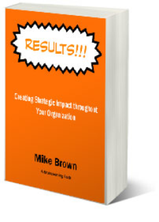When a brand strategy change is planned, what happens first?
An earlier “Inside the Executive Suite” article from Armada Corporate Intelligence addressed this important brand strategy question about how changes are rolled out to the public. The issue is this: When announcing a new brand promise, you need to give employees adequate time to understand and embrace the brand promise before announcing it to customers.
“Nearly simultaneously,” unless there are completely inescapable circumstances preventing advance notice, is not adequate time. Yet, discussions and presentations at a brand strategy conference indicate many brands act as if "nearly simultaneously" is sufficient.
They're wrong, and here's an example included in the Armada piece. It's a second-hand anecdote on the downside of not making sure employees know about branding announcement before customers, along with the fundamental differences in how brands are developed vs. implemented.
Brand Promises Are Developed and Communicated in Different Directions (From Armada Executive Intelligence “Inside the Executive Suite”)
“(There are) differing 'directions' in which smart brands develop and introduce their promises.
Many organizations first look inward to determine what they want the brand to be. They then develop related brand messages they launch with great fanfare in the marketplace. This is developing the brand promise 'inside-out' and communicating it 'outside-in,' implying employees are learning about the new big brand promise at the same time as customers.
“That approach is fraught with problems as evidenced by a story shared by a CMO we (worked with). He was flying on United Airlines as it introduced 'United Rising.' The brand campaign focused on United dramatically changing to deliver better service to customers. After enduring a day of cancellations and delays at O'Hare with no timely updates or apologies from United, passengers finally boarded a plane in the evening. One flight attendant welcomed passengers, acknowledged their long, frustrating day, apologized, and said the crew would have them home soon.
“The CMO told the flight attendant she was the ONLY person all day who displayed anything resembling United Rising-type behaviors. She asked what United Rising was. He explained it was the new United brand message. She replied, ‘Oh, they don't tell us about those things. We're always the last to know.’
“That highlights the problem with first communicating a brand promise in the marketplace. If the market learns about a new brand promise before employees, they aren't in a good position to bring the brand promise to life for customers - and they may even wind up undermining it, as in the United Rising episode.
“The best brand promises are developed outside in. A brand starts by understanding what the market perceives about it and how much latitude it has to change. Brand promises are then communicated inside out. The communication process starts with employees before the market hears the message, making sure they understand it and are supported in delivering on it. Then, when the first customer comes through the door (whether a physical, figurative, or virtual one), employee behaviors and every other brand element can strongly align to what customers have heard.”
Even if there are regulatory or confidentiality issues involved, it behooves a brand to establish considerable groundwork with its employees in advance, perhaps over many months of time. This could come via broad employee involvement in providing input to the strategy. It could also include sharing foundational concepts that will support the eventual brand position. In that case, when the new brand is announced, brand management can link the new information on the brand to what has already been shared. That at least provides SOME context and preparation for employees to be able to communicate about and carry out a new brand promise more effectively.
Don't mess this one up: Communicating your brand starts on the inside, NOT the outside! - Mike Brown
10 Keys to Engaging Stakeholders to Create Improved Results
FREE Download: "Results!!! Creating Strategic Impact"
Leaders are looking for powerful ways to engage strong collaborators to shape shared visions. They need strategic thinkers who can develop strategy and turn it into results.
This new Brainzooming mini-book, "Results - Creating Strategic Impact" unveils ten proven lessons for leaders to increase strategic collaboration, engagement, and create improved results.
Download this free, action-focused mini-book to:
- Learn smart ways to separate strategic opportunities from the daily noise of business
- Increase focus for your team with productive strategy questions everyone can use
- Actively engage stakeholders in strategy AND implementation success






